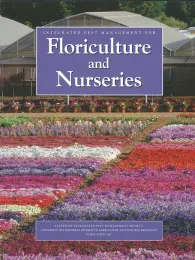References for Plant Disease and Pest Identification and Management for California Ornamentals
To diagnose plant problems, one must take the approach of a detective. Begin with identifying the plant or plants where the problem is occurring. Characterize the problem by describing the symptoms. Are there leaf, stem or root galls, wilted or yellowed leaves, discolored or rotted roots, distorted leaves, chewed or stippled leaves? When did symptoms occur? Look for evidence or signs of the pathogen, insect or other pest. Look for insect sooty mold or honeydew or other byproducts of an insect infestation. Look for patterns of the symptoms or plant damage. Gather appropriate information on plant culture, pesticide applications, and weather or the greenhouse environment. Is there something extraordinary that occurred that could be the cause of the problem? Maybe a sample needs to be taken to a diagnostic laboratory for culturing or pest identification.
Once the information has been gathered, it's time to review the possible problems by using references. Do the symptoms, and environmental conditions fit those listed and described? These references need to give enough information to aid identification and enough information to help manage the problem. But what references to use? For California ornamental production, I have relied on a few general references that have aided in the identification and management of plant diseases, insects and vertebrates. These are UC publications, and I have provided links where they can be obtained.

In this reference, crop tables give you a symptom-based guide for diagnosing problems and the recommended controls for problems affecting 120 major flower and foliage species. It's loaded with outstanding color photos and diagrams, references, suppliers, and a comprehensive index. You'll learn how to establish an IPM program for your nursery, techniques for managing pests in flower and nursery crops, how good cultural practices can nip problems in the bud, disease control techniques for root and crown decays, vascular wilt diseases, and pathogens infecting flowers and foliage, how to identify and manage aphids, leafminers, thrips, whiteflies, mites, nematodes and weeds.
https://anrcatalog.ucanr.edu/Details.aspx?itemNo=3402
Pests of Landscape Trees and Shrubs
Although this reference is directed to the professional working with trees and shrubs in the landscape, I have found it to be very useful for identifying problems on woody plants in our California nurseries. The pests and information listed in this reference often supplements those that are covered in “IPM for Floriculture and Nursery”. It contains two tables that can be used for problem solving. One table uses the “describe symptom first” approach and the other table starts with “identifying the host first” approach. This manual covers hundreds of pests, including insects, mites, nematodes, plant diseases, and weeds that can damage California woody ornamentals.
https://anrcatalog.ucanr.edu/Details.aspx?itemNo=3359
Pests of the Garden and Small Farm
Because many of our California nurseries often produce a wide range of crops, including edible crops, it is often necessary to have a good pest reference for vegetable, herb, and fruit tree pests. Again, in this manual, there are good crop-specific lists that include common pests and diseases found in California. It covers the IPM approach, and the methods recommended rely primarily on organically acceptable alternatives.
https://anrcatalog.ucanr.edu/Details.aspx?itemNo=3332
Wildlife Pest Control Around Gardens and Homes
Where do you turn for information if you suspect a vertebrate pest in your nursery or greenhouse? These are sometimes the most fascinating problems. (I have seen evidence of mice eating only the nectaries from carnation flowers in greenhouses; but only one particular variety, was chosen from about 50 available. It was clearly the most fragrant of all and smelled just like cloves!). These problems are often easy to identify (I have seen wild pigs rampaging through a field of hydrangeas), but what is their biology and how do you manage them? It's something plant people sometimes need to know. This is when this reference really becomes useful.
https://anrcatalog.ucanr.edu/Details.aspx?itemNo=21385
UC IPM
UC Statewide Integrated Pest Management Program
This is an online version of much of the information given in the references described above. However, this online version is not going to beat the quality and quantity of images, figures, and tables, and depth of information found in the references. What the references lack, however, UC IPM online has. It gives current pesticide recommendations for the listed pests and diseases.
Merry Christmas and Happy Holidays!
